2012 FORD SUPER DUTY steering
[x] Cancel search: steeringPage 14 of 93
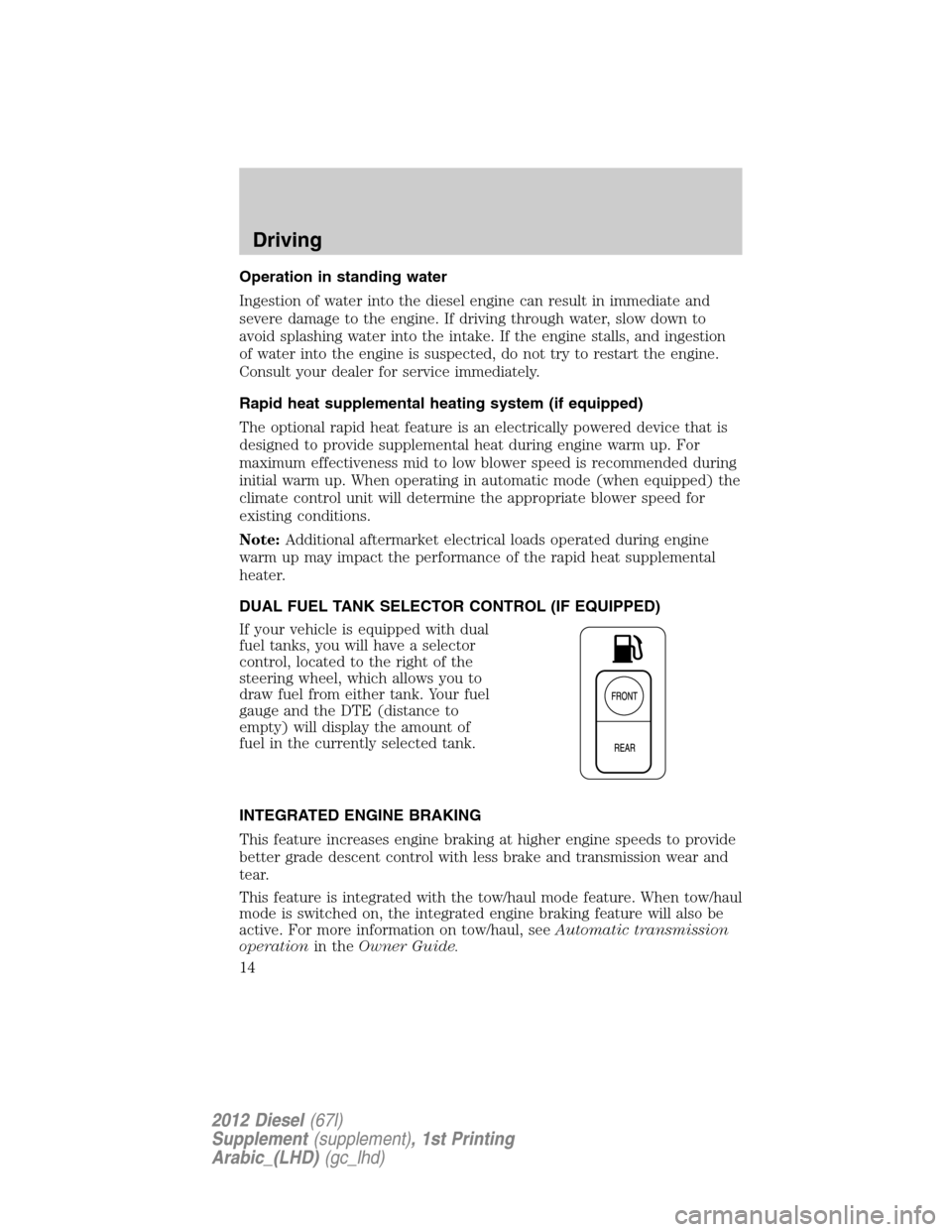
Operation in standing water
Ingestion of water into the diesel engine can result in immediate and
severe damage to the engine. If driving through water, slow down to
avoid splashing water into the intake. If the engine stalls, and ingestion
of water into the engine is suspected, do not try to restart the engine.
Consult your dealer for service immediately.
Rapid heat supplemental heating system (if equipped)
The optional rapid heat feature is an electrically powered device that is
designed to provide supplemental heat during engine warm up. For
maximum effectiveness mid to low blower speed is recommended during
initial warm up. When operating in automatic mode (when equipped) the
climate control unit will determine the appropriate blower speed for
existing conditions.
Note:Additional aftermarket electrical loads operated during engine
warm up may impact the performance of the rapid heat supplemental
heater.
DUAL FUEL TANK SELECTOR CONTROL (IF EQUIPPED)
If your vehicle is equipped with dual
fuel tanks, you will have a selector
control, located to the right of the
steering wheel, which allows you to
draw fuel from either tank. Your fuel
gauge and the DTE (distance to
empty) will display the amount of
fuel in the currently selected tank.
INTEGRATED ENGINE BRAKING
This feature increases engine braking at higher engine speeds to provide
better grade descent control with less brake and transmission wear and
tear.
This feature is integrated with the tow/haul mode feature. When tow/haul
mode is switched on, the integrated engine braking feature will also be
active. For more information on tow/haul, seeAutomatic transmission
operationin theOwner Guide.
Driving
14
2012 Diesel(67l)
Supplement(supplement), 1st Printing
Arabic_(LHD)(gc_lhd)
Page 20 of 93
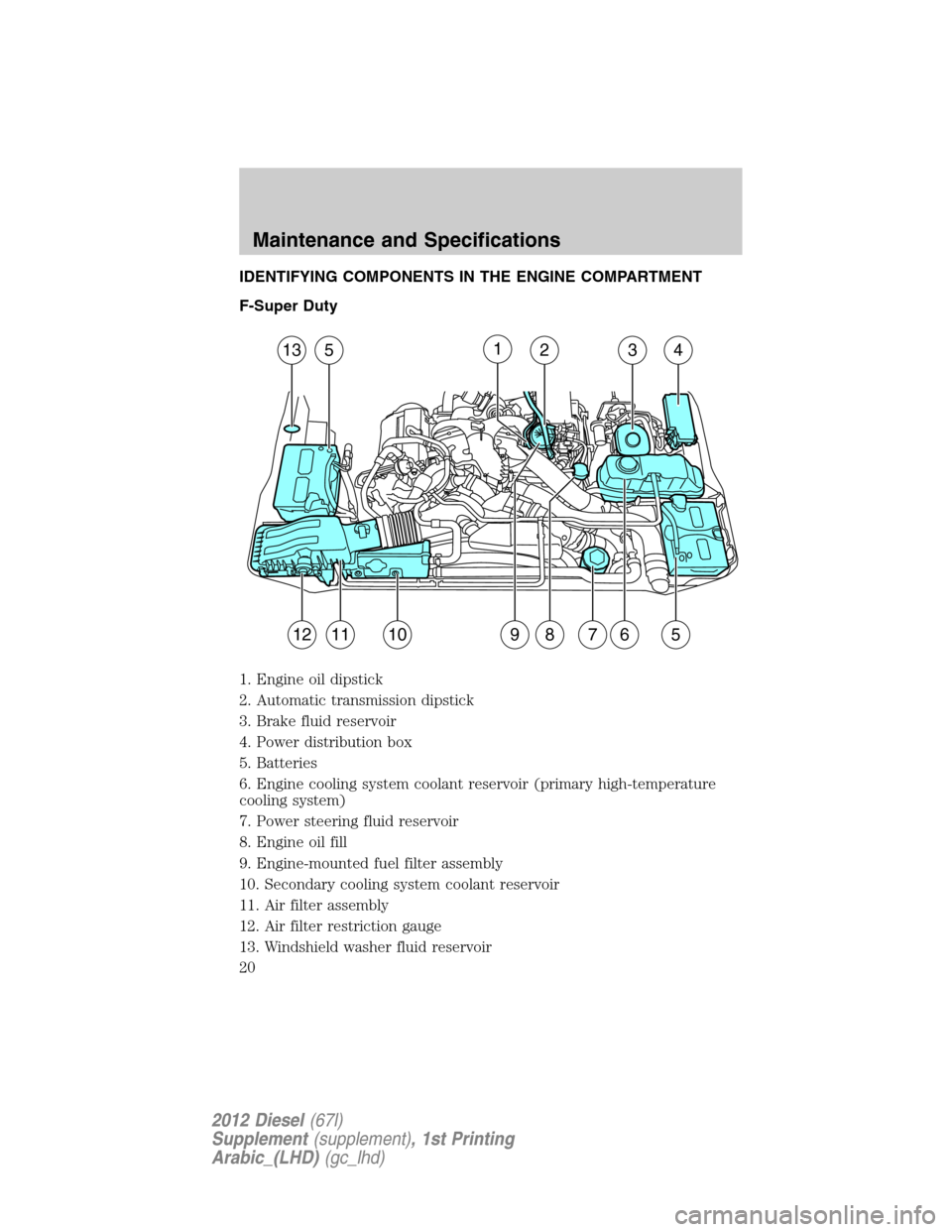
IDENTIFYING COMPONENTS IN THE ENGINE COMPARTMENT
F-Super Duty
1. Engine oil dipstick
2. Automatic transmission dipstick
3. Brake fluid reservoir
4. Power distribution box
5. Batteries
6. Engine cooling system coolant reservoir (primary high-temperature
cooling system)
7. Power steering fluid reservoir
8. Engine oil fill
9. Engine-mounted fuel filter assembly
10. Secondary cooling system coolant reservoir
11. Air filter assembly
12. Air filter restriction gauge
13. Windshield washer fluid reservoir
1135234
57691012118
Maintenance and Specifications
20
2012 Diesel(67l)
Supplement(supplement), 1st Printing
Arabic_(LHD)(gc_lhd)
Page 57 of 93
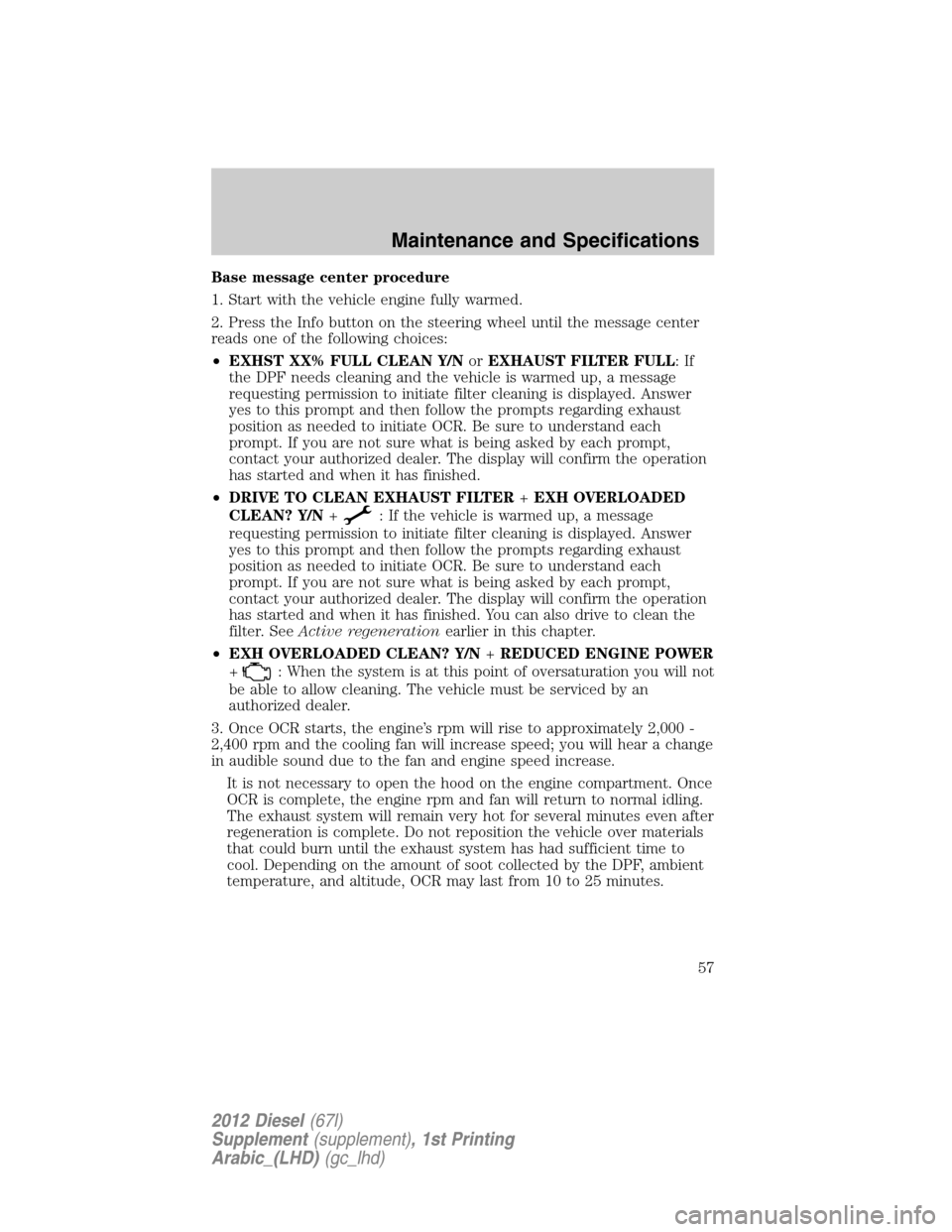
Base message center procedure
1. Start with the vehicle engine fully warmed.
2. Press the Info button on the steering wheel until the message center
reads one of the following choices:
•EXHST XX% FULL CLEAN Y/NorEXHAUST FILTER FULL:If
the DPF needs cleaning and the vehicle is warmed up, a message
requesting permission to initiate filter cleaning is displayed. Answer
yes to this prompt and then follow the prompts regarding exhaust
position as needed to initiate OCR. Be sure to understand each
prompt. If you are not sure what is being asked by each prompt,
contact your authorized dealer. The display will confirm the operation
has started and when it has finished.
•DRIVE TO CLEAN EXHAUST FILTER+EXH OVERLOADED
CLEAN? Y/N+
: If the vehicle is warmed up, a message
requesting permission to initiate filter cleaning is displayed. Answer
yes to this prompt and then follow the prompts regarding exhaust
position as needed to initiate OCR. Be sure to understand each
prompt. If you are not sure what is being asked by each prompt,
contact your authorized dealer. The display will confirm the operation
has started and when it has finished. You can also drive to clean the
filter. SeeActive regenerationearlier in this chapter.
•EXH OVERLOADED CLEAN? Y/N+REDUCED ENGINE POWER
+
: When the system is at this point of oversaturation you will not
be able to allow cleaning. The vehicle must be serviced by an
authorized dealer.
3. Once OCR starts, the engine’s rpm will rise to approximately 2,000 -
2,400 rpm and the cooling fan will increase speed; you will hear a change
in audible sound due to the fan and engine speed increase.
It is not necessary to open the hood on the engine compartment. Once
OCR is complete, the engine rpm and fan will return to normal idling.
The exhaust system will remain very hot for several minutes even after
regeneration is complete. Do not reposition the vehicle over materials
that could burn until the exhaust system has had sufficient time to
cool. Depending on the amount of soot collected by the DPF, ambient
temperature, and altitude, OCR may last from 10 to 25 minutes.
Maintenance and Specifications
57
2012 Diesel(67l)
Supplement(supplement), 1st Printing
Arabic_(LHD)(gc_lhd)
Page 72 of 93
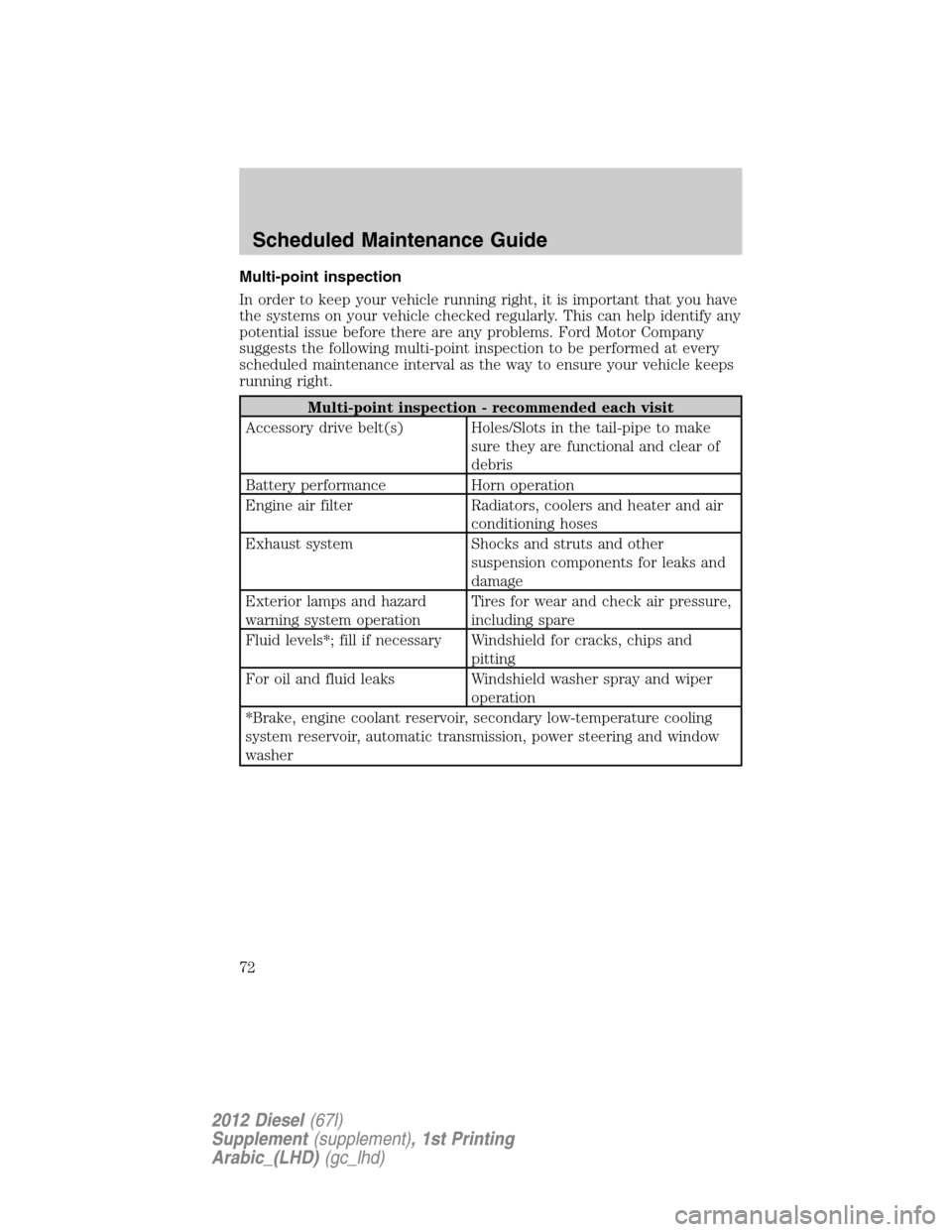
Multi-point inspection
In order to keep your vehicle running right, it is important that you have
the systems on your vehicle checked regularly. This can help identify any
potential issue before there are any problems. Ford Motor Company
suggests the following multi-point inspection to be performed at every
scheduled maintenance interval as the way to ensure your vehicle keeps
running right.
Multi-point inspection - recommended each visit
Accessory drive belt(s) Holes/Slots in the tail-pipe to make
sure they are functional and clear of
debris
Battery performance Horn operation
Engine air filter Radiators, coolers and heater and air
conditioning hoses
Exhaust system Shocks and struts and other
suspension components for leaks and
damage
Exterior lamps and hazard
warning system operationTires for wear and check air pressure,
including spare
Fluid levels*; fill if necessary Windshield for cracks, chips and
pitting
For oil and fluid leaks Windshield washer spray and wiper
operation
*Brake, engine coolant reservoir, secondary low-temperature cooling
system reservoir, automatic transmission, power steering and window
washer
Scheduled Maintenance Guide
72
2012 Diesel(67l)
Supplement(supplement), 1st Printing
Arabic_(LHD)(gc_lhd)
Page 74 of 93
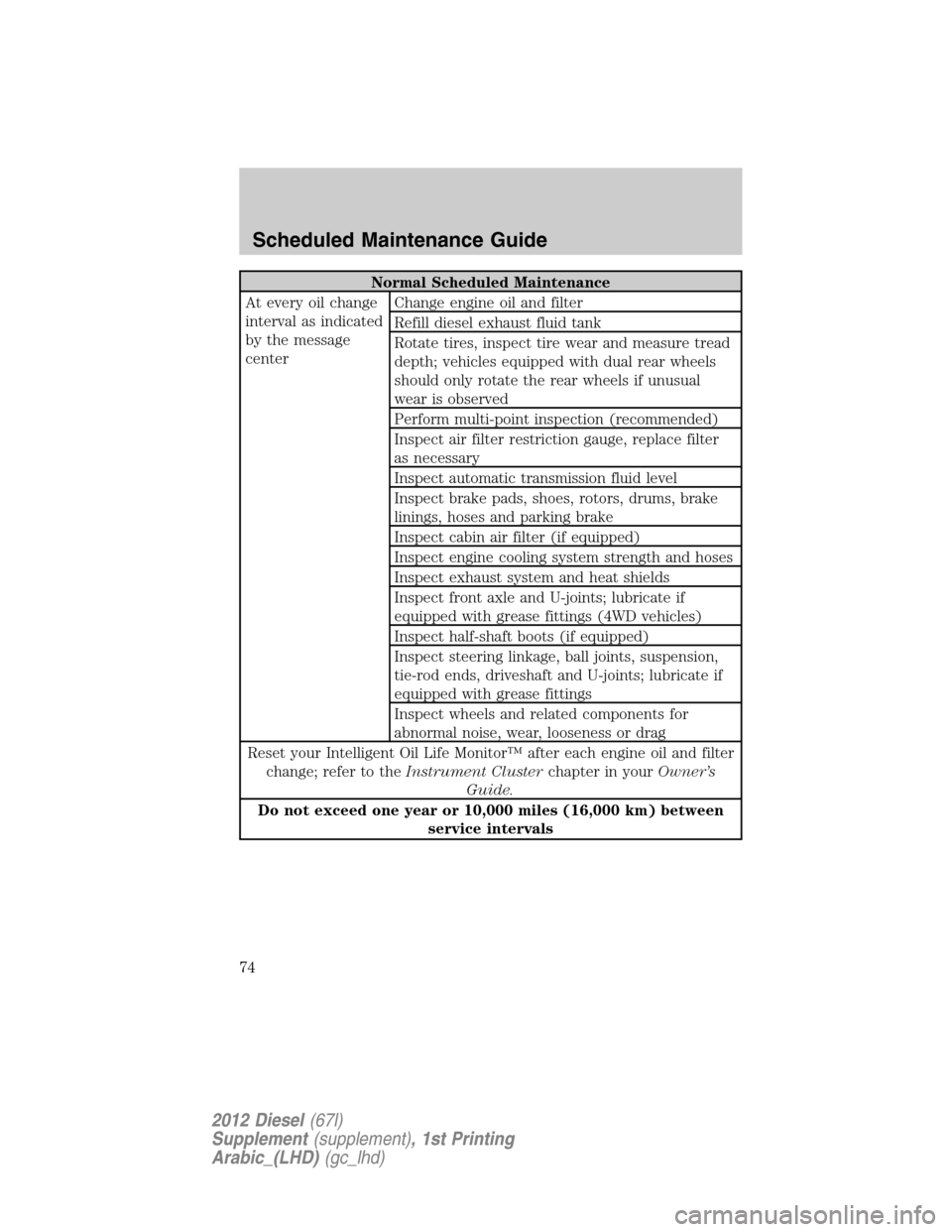
Normal Scheduled Maintenance
At every oil change
interval as indicated
by the message
centerChange engine oil and filter
Refill diesel exhaust fluid tank
Rotate tires, inspect tire wear and measure tread
depth; vehicles equipped with dual rear wheels
should only rotate the rear wheels if unusual
wear is observed
Perform multi-point inspection (recommended)
Inspect air filter restriction gauge, replace filter
as necessary
Inspect automatic transmission fluid level
Inspect brake pads, shoes, rotors, drums, brake
linings, hoses and parking brake
Inspect cabin air filter (if equipped)
Inspect engine cooling system strength and hoses
Inspect exhaust system and heat shields
Inspect front axle and U-joints; lubricate if
equipped with grease fittings (4WD vehicles)
Inspect half-shaft boots (if equipped)
Inspect steering linkage, ball joints, suspension,
tie-rod ends, driveshaft and U-joints; lubricate if
equipped with grease fittings
Inspect wheels and related components for
abnormal noise, wear, looseness or drag
Reset your Intelligent Oil Life Monitor™ after each engine oil and filter
change; refer to theInstrument Clusterchapter in yourOwner’s
Guide.
Do not exceed one year or 10,000 miles (16,000 km) between
service intervals
Scheduled Maintenance Guide
74
2012 Diesel(67l)
Supplement(supplement), 1st Printing
Arabic_(LHD)(gc_lhd)
Page 85 of 93
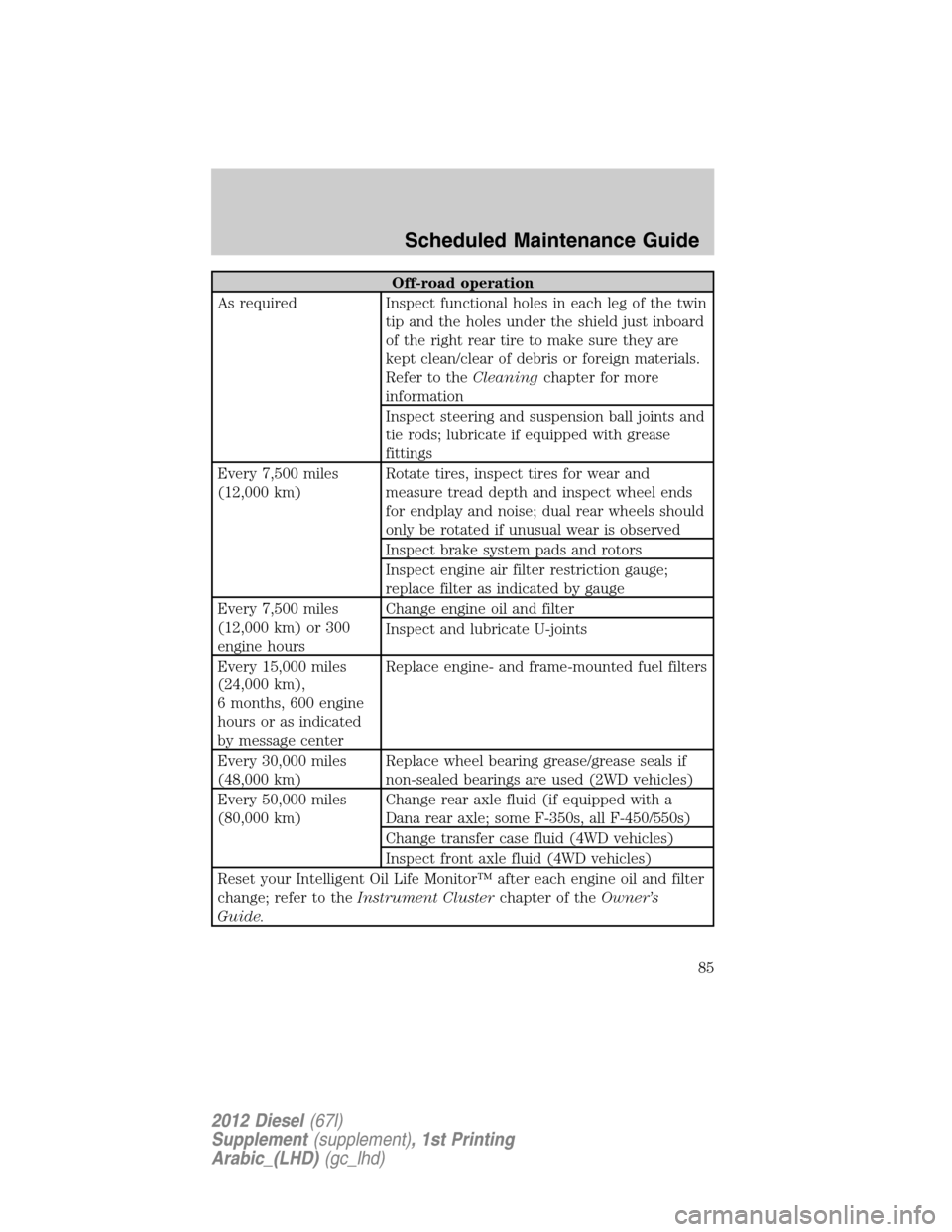
Off-road operation
As required Inspect functional holes in each leg of the twin
tip and the holes under the shield just inboard
of the right rear tire to make sure they are
kept clean/clear of debris or foreign materials.
Refer to theCleaningchapter for more
information
Inspect steering and suspension ball joints and
tie rods; lubricate if equipped with grease
fittings
Every 7,500 miles
(12,000 km)Rotate tires, inspect tires for wear and
measure tread depth and inspect wheel ends
for endplay and noise; dual rear wheels should
only be rotated if unusual wear is observed
Inspect brake system pads and rotors
Inspect engine air filter restriction gauge;
replace filter as indicated by gauge
Every 7,500 miles
(12,000 km) or 300
engine hoursChange engine oil and filter
Inspect and lubricate U-joints
Every 15,000 miles
(24,000 km),
6 months, 600 engine
hours or as indicated
by message centerReplace engine- and frame-mounted fuel filters
Every 30,000 miles
(48,000 km)Replace wheel bearing grease/grease seals if
non-sealed bearings are used (2WD vehicles)
Every 50,000 miles
(80,000 km)Change rear axle fluid (if equipped with a
Dana rear axle; some F-350s, all F-450/550s)
Change transfer case fluid (4WD vehicles)
Inspect front axle fluid (4WD vehicles)
Reset your Intelligent Oil Life Monitor™ after each engine oil and filter
change; refer to theInstrument Clusterchapter of theOwner’s
Guide.
Scheduled Maintenance Guide
85
2012 Diesel(67l)
Supplement(supplement), 1st Printing
Arabic_(LHD)(gc_lhd)
Page 86 of 93
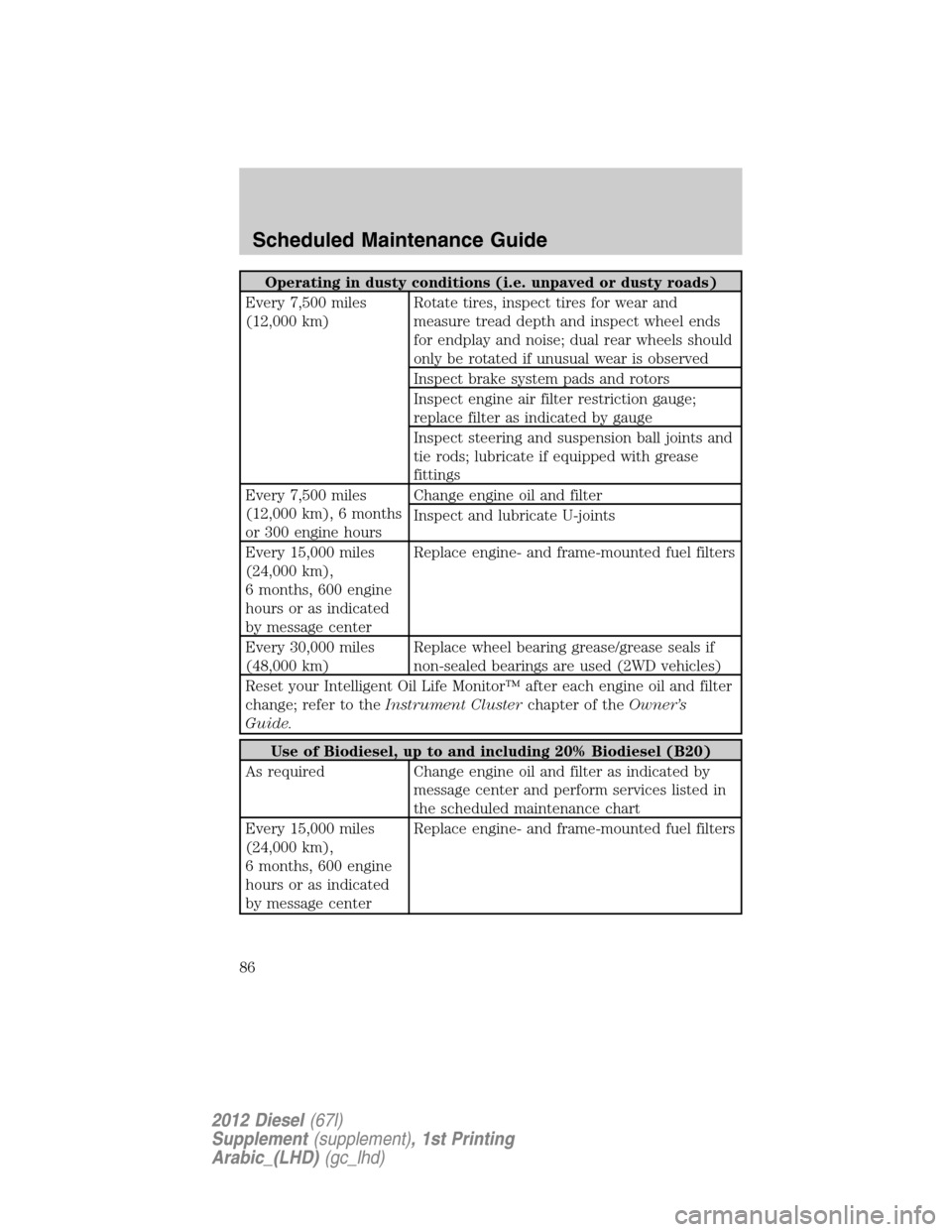
Operating in dusty conditions (i.e. unpaved or dusty roads)
Every 7,500 miles
(12,000 km)Rotate tires, inspect tires for wear and
measure tread depth and inspect wheel ends
for endplay and noise; dual rear wheels should
only be rotated if unusual wear is observed
Inspect brake system pads and rotors
Inspect engine air filter restriction gauge;
replace filter as indicated by gauge
Inspect steering and suspension ball joints and
tie rods; lubricate if equipped with grease
fittings
Every 7,500 miles
(12,000 km), 6 months
or 300 engine hoursChange engine oil and filter
Inspect and lubricate U-joints
Every 15,000 miles
(24,000 km),
6 months, 600 engine
hours or as indicated
by message centerReplace engine- and frame-mounted fuel filters
Every 30,000 miles
(48,000 km)Replace wheel bearing grease/grease seals if
non-sealed bearings are used (2WD vehicles)
Reset your Intelligent Oil Life Monitor™ after each engine oil and filter
change; refer to theInstrument Clusterchapter of theOwner’s
Guide.
Use of Biodiesel, up to and including 20% Biodiesel (B20)
As required Change engine oil and filter as indicated by
message center and perform services listed in
the scheduled maintenance chart
Every 15,000 miles
(24,000 km),
6 months, 600 engine
hours or as indicated
by message centerReplace engine- and frame-mounted fuel filters
Scheduled Maintenance Guide
86
2012 Diesel(67l)
Supplement(supplement), 1st Printing
Arabic_(LHD)(gc_lhd)